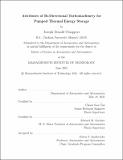Attributes of Bi-Directional Turbomachinery for Pumped Thermal Energy Storage
Author(s)
Chiapperi, Joseph Donald
DownloadThesis PDF (2.537Mb)
Advisor
Tan, Choon Sooi
Greitzer, Edward M.
Terms of use
Metadata
Show full item recordAbstract
In this thesis we (i) present a methodology for determining the aerodynamic performance of bi-directional turbomachines for pumped thermal energy storage, i.e., turbomachines designed to operate with both forward and backward flow, (ii) carry out performance computations for such turbomachines, and (iii) propose principles for conceptual design of these devices. Focus is placed on using the energy storage cycle not to only identify the unique requirements placed on bi-directional turbomachines, but also to estimate what effect these requirements have on the round-trip efficiency of the energy storage process. In particular, it is shown how the difference between aerodynamic loading in forward and in backward operation causes the blading to work at incidences leading to performance below the blading’s maximum efficiency.
The proposed design principles use a 50MW counter-rotating bi-directional turbomachine, being developed by Brayton Energy LLC, as a context from which to assess different features. The description of the design principles includes determination of the appropriate number of stages, definition of relevant non-dimensional parameters for blading selection, and optimization of two-dimensional blading for bi-directional operation. The assessment of stage count shows the relationship between relative Mach number, pressure ratio, and round-trip efficiency. The non-dimensional parameter assessment creates a bi-directional analogue to existing “Smith charts”, for single direction turbomachines, using camber and stagger. The two-dimensional blade shape evaluation and optimization shows how the blade profile can be modified to address the unique requirements of a bi-directional turbomachine, enabling an increase in round-trip efficiency of 2 percentage points compared to a baseline configuration.
Date issued
2021-06Department
Massachusetts Institute of Technology. Department of Aeronautics and AstronauticsPublisher
Massachusetts Institute of Technology